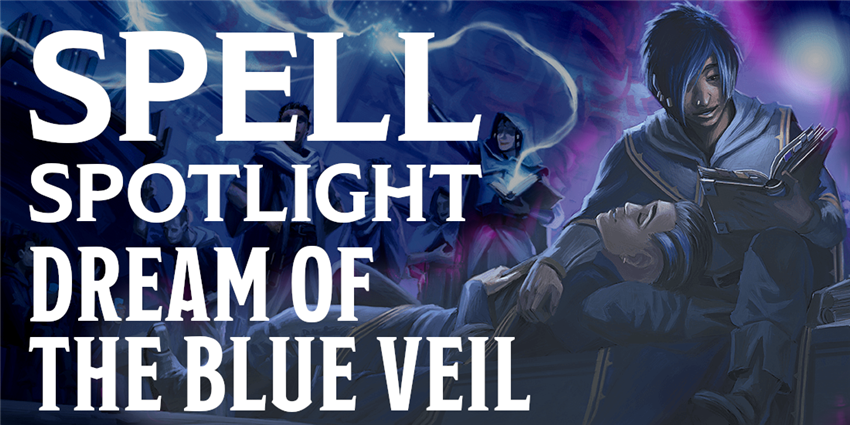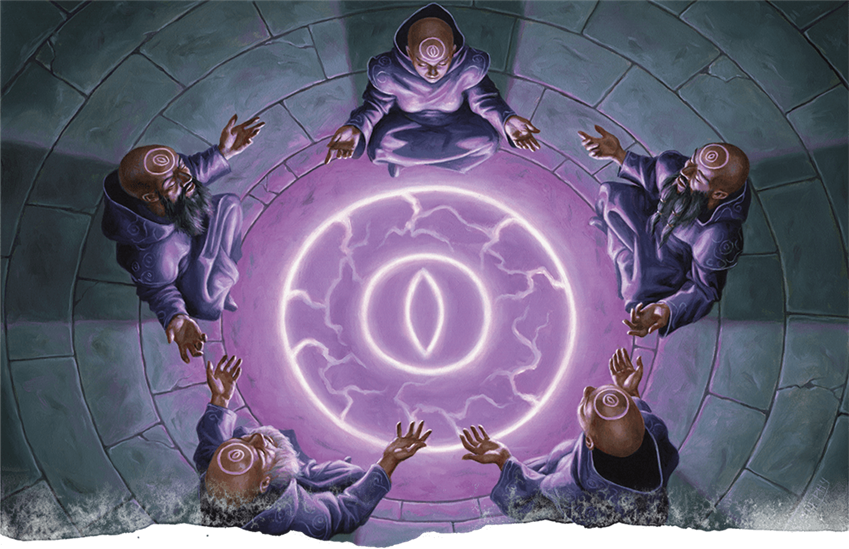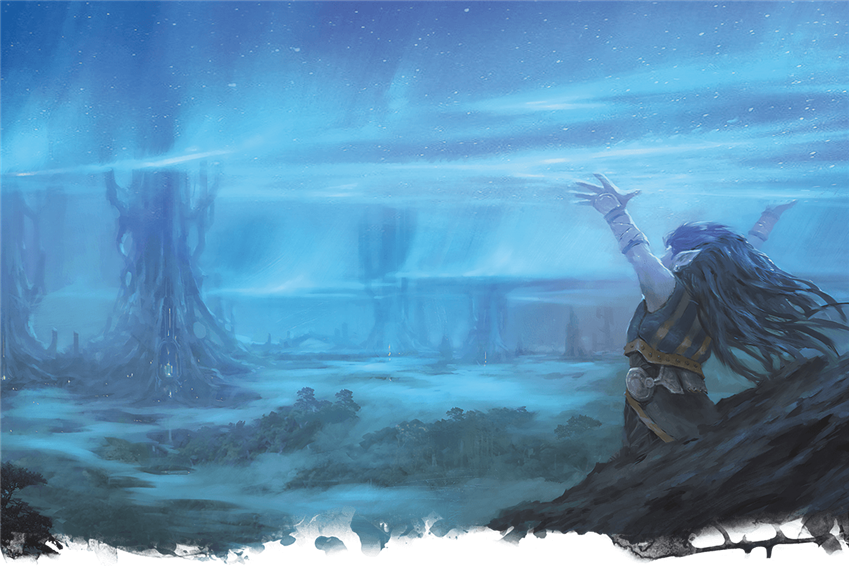Spell Spotlight examines D&D’s best, worst, and most interesting spells, giving you the tools you need to play a spellcaster who knows exactly what they’re doing. Today, we’re looking at a fascinating new spell from Tasha’s Cauldron of Everything that could transform your Dungeons & Dragons campaign: dream of the blue veil. Available to bards, sorcerers, warlocks, and wizards, this is an arcane spell that stands tall in the company of spells like teleport and plane shift. Its applications are straightforward—get from one place to another in the blink of an eye—but the where you wish to go could turn your Dungeon Master’s hair white (not blue) with shock!

For Players: Why Use Dream of the Blue Veil?
The Material Plane holds an infinite number of worlds. Some—like Oerth, Toril, Krynn, and Eberron—are well documented, but there are countless others. You and your friends may even have created some homemade D&D worlds yourselves!
Transit between these worlds is rare but not impossible and can be accomplished in various ways. One such method is […] the Dream of Other Worlds; travelers fall into a deep slumber and dream themselves into a new realm. The spell dream of the blue veil employs this method of transit. […] Whatever method you use to reach a world, the DM determines whether you succeed and where exactly you appear if you do arrive in that realm.
You know what they say: the world is not enough. One world isn’t, anyway. Teleport can take you from place to place on your world, and plane shift can take you to other realities, but the methods of travel between other worlds on the Material Plane aren’t so commonly known. There are several ways, at least one of which can only be accomplished by overcoming a grand and perilous journey—the stuff that epic adventures are made of! If you want your journey between worlds to be a little bit less harrowing, and you have the skill with arcane magic necessary to cast a 7th-level spell, dream of the blue veil is a much faster option, and it’s as easy as counting sheep.
So, why travel between worlds? What does Wildemount offer that Faerûn doesn’t, for example? There are plenty of reasons. You could just want a vacation, of course. I’ve heard that the Menagerie Coast is beautiful this time of year—and the Feolinn wineries are just starting to do their first tastings of the season. Dream of the blue veil is truly the private jet of the magically mighty.
But if you aren’t keen on spending 7th-level spell slots on frivolous endeavors, consider how useful it would be to escape to a realm where no one has ever heard your name. Depending on what world you go to, people may not have even met another person of your race before! A kalashtar wizard who uses the dream to flee the agents of the Dreaming Dark by escaping to Krynn may buy themself enough time to gather new allies, new resources, and return to Eberron with a bold new plan to defeat their enemies.
There may be plot reasons for the characters to seek a way to pierce the veil between worlds—an artifact or an oracle or some other MacGuffin resides on another world—but that’s such a DM-motivated endeavor that it hardly seems worth discussing here in the player-focused side of the article. A more interesting way of doing this sort of plot is to seed it at the very beginning. Perhaps your character is from another world, and on the morning of the first session of the campaign, they awoke in an unfamiliar inn, in an unfamiliar town, in an unfamiliar world. Some fifty sessions later, the party has grown to be heroes known throughout the land and the wizard has some mighty spells at their disposal—and they learn that some MacGuffin is on another world. Your homeworld. Now, your character has a personal connection to the unfolding saga of the dream of the blue veil, especially since…

The Dream’s Material Component: An Easily Overlooked Necessity
Buried at the bottom of the spell description (at least on D&D Beyond’s spell page), is a crucial material component. Do not overlook this. Using this spell requires you to have “a magic item or a willing creature” from the world you wish to travel to using the dream. Since acquiring such an item is entirely dependent upon your Dungeon Master providing the opportunity for such an item or creature to fall into the players’ clutches.
If you’re a player who saw this spell and got a mischievous little glint in your eye, and began dreaming of ways to juke the DM and derail your campaign by suddenly taking a vacation in Eberron from your problems in Faerûn, you’re fresh out of luck. These things work better for everyone when the DM is in on the joke, anyway! Let them know that you want to launch an otherworldly side-story and try to convince them into dropping the skull of a warforged that originated on Eberron into their next dungeon.
For Dungeon Masters: Planning a Multi-World Story
Once your players’ characters reach 13th level—the minimum level needed for a bard, sorcerer, warlock, or wizard to cast dream of the blue veil, a 7th-level spell—you’ll have hopefully played with that party enough to know what kind of adventures they like. It becomes tricky to run pre-published adventures at this high of a level, since your game will likely have become so idiosyncratic that any hardback adventure will need to be retooled significantly to suit your players’ preferences—to say nothing of your own!

So, break out your Dungeon Master’s Guide and start thinking about the power of other worlds. Check out other campaign settings, like Eberron: Rising from the Last War and Explorer’s Guide to Wildemount, and see what sets those worlds apart from others. Or better yet, check out the worldbuilding advice in chapter 1 of the Dungeon Master’s Guide and create your own new world for the party to explore. After all, published campaign settings aren’t the only worlds on the Material Plane. There are countless worlds. Some might be full, Earth-like fantasy settings that require you to do bookloads of worldbuilding, while others might be blasted rocks with only carefully woven spells from a long-dead civilization keeping their thin atmospheres from spiraling out into the great void beyond. A world like this could be planned in an afternoon, and provide enough adventure for a couple sessions’ worth of “dungeon” crawling.
So, why create a story that spans more than one world? One of the best reasons to do so is because you had an old campaign on another world, and now you want to involve retired characters or old NPCs in your current story. That’s a great way to get your old players’ interest!
Creating a worlds-spanning story can also crank up the epic scale of your story, and shift it from heroic fantasy into a more science-fantasy or “sword and planet” genre. This is the approach that D&D’s currently-dormant Spelljammer setting takes, as has the MMORPG World of Warcraft with expansions like The Burning Crusade and Legion. Beloved classic adventure games like The Legend of Zelda: A Link to the Past and Tales of Symphonia use parallel worlds to create a vast story that can draw interesting thematic parallels between one reality and another.
What will you do with the power to create worlds-spanning adventures? Are you a DM or a player—and what will you use this interesting new spell to do in your campaign?
Create A Brand-New Adventurer Acquire New Powers and Adventures Browse All Your D&D Content
 James Haeck is the lead writer for D&D Beyond, the co-author of Waterdeep: Dragon Heist, Baldur's Gate: Descent into Avernus, and the Critical Role Explorer's Guide to Wildemount, a member of the Guild Adepts, and a freelance writer for Wizards of the Coast, the D&D Adventurers League, and other RPG companies. He lives in Seattle, Washington with his fiancée Hannah and their animal companions Mei and Marzipan. You can find him wasting time on Twitter at @jamesjhaeck.
James Haeck is the lead writer for D&D Beyond, the co-author of Waterdeep: Dragon Heist, Baldur's Gate: Descent into Avernus, and the Critical Role Explorer's Guide to Wildemount, a member of the Guild Adepts, and a freelance writer for Wizards of the Coast, the D&D Adventurers League, and other RPG companies. He lives in Seattle, Washington with his fiancée Hannah and their animal companions Mei and Marzipan. You can find him wasting time on Twitter at @jamesjhaeck.











-
View User Profile
-
Send Message
Posted Dec 7, 2020Well, same goes for any spell. The DM could just say a powerful lich counterspelled it.
-
View User Profile
-
Send Message
Posted Dec 7, 2020Aralia_AKA_GoogiddyBop make the spell unknown in your world ie it exists but no one knows what the spell is, tales begin popping up of people who fell asleep and vanished hours later, ban players from taking the spell but add the potential of a scroll being found.
Also, if everyone is from different worlds (and you have a wizard who puts the spell in their book) you would have a really nice goodbye scene where one bye one the party get to see the world a character grew up in before they step through the veil and get a chance to explore/take a long rest at their home before leaving that character to send another to their home, repeat until just the wizard is left and he too goes home or world hops keeping the multiverse in balance.
Just a thought
-
View User Profile
-
Send Message
Posted Dec 7, 2020i think i will have the villian have a scroll of it instead of my other idea but thank you for the suggestion
-
View User Profile
-
Send Message
Posted Dec 7, 2020No problem
-
View User Profile
-
Send Message
Posted Dec 8, 2020i like the idea of the spell having unforeseen consequences awakening an elder evil. Allowing that kind of player agency on a level that influences the setting of the story you're all telling together i think authorizes you as the DM to add you own world changing surprises into the mix. Perhaps Atropus, the World Born Dead detects the powerful world-linking magic as it is cast and begins to track the casters to one world or the other. Even if you wait until a point in the campaign when your PCs are very high level, it would create a powerful motivator for them when they realize that their actions have endangered not only their world but also another.
-
View User Profile
-
Send Message
Posted Dec 8, 2020Can I just say how much I love the art at the top of the article. I love that D&D is being inclusive!
-
View User Profile
-
Send Message
Posted Dec 9, 2020Nice, this beat my idea of using the trinket table's 9v battery.
-
View User Profile
-
Send Message
Posted Dec 9, 2020Nice, this beat my idea of using the trinket table's 9v battery.
-
View User Profile
-
Send Message
Posted Dec 9, 2020No, this doesn't take you to a different plane. All worlds are on the material plane.
-
View User Profile
-
Send Message
Posted Dec 9, 2020"Get in in losers, we're going to Krynn!"
-
View User Profile
-
Send Message
Posted Dec 10, 2020'Tash's Cauldron of Everything. Awaken your Planeswalker spark today!'
-
View User Profile
-
Send Message
Posted Dec 10, 2020It said in the article that you would need your DM to put the material componiont in the story, but with a Wish spell, you could bypass the material componionts, and with Collage of Creation Bard, you can at a certain level, ignore the cost restriction and make anything within a certain size range. So I guess there are two ways to do it without your DM's permission.
(It might annoy them, but it would be so fun!!!)
-
View User Profile
-
Send Message
Posted Dec 10, 2020A wish spell could work since it is a 9th level spell. But I don’t see how Creation Bard would work since it can’t create magic items or living creatures. And even if it could wouldn’t they count as creations of the world you are on rather than of the destination world?
-
View User Profile
-
Send Message
Posted Dec 10, 2020I was thinking with the creation bard that they could make something like a warforged skull to go to ebberon or something like that, but I guess it would be something from your world then.
-
View User Profile
-
Send Message
Posted Dec 10, 2020With my interpretations, the components for the spell need to be a magic item or a willing living creature that are from the destination world. With the creation bard you can’t make magic items or living creatures, and what you can make was created right then and there and has never been anywhere else.
But you are being creative.
-
View User Profile
-
Send Message
Posted Dec 10, 2020Careful...you DM will probably open up the monster manual to page 286 as soon as they hear you are doing this and say "are you sure you want to" over the top of it, showing you the monster manual but not where it is opened to.
-
View User Profile
-
Send Message
Posted Dec 10, 2020what is on the monster manual on page 286?
lemme guess, Tarrasque or some other ultra-powerful creature...
-
View User Profile
-
Send Message
Posted Dec 10, 2020Probably.
-
View User Profile
-
Send Message
Posted Dec 11, 2020Then you buy Guildmaster's Guide to Ravnica!
-
View User Profile
-
Send Message
Posted Dec 12, 2020"Can the spell transport creatures to any time/space on the other plane? For example, could you travel to Eberron, stay for a few days, then travel back to Faerun 2000 years after you left?"
I do not think so. The spell only states that it takes the creatures to a other place but says nothing about time travel. If the DM says "One day in Ebberon is one day on the main plane." or something similar then technically yes. Talk to the DM about it.